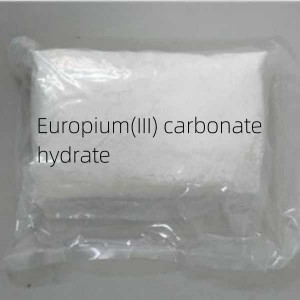Zirconium tetrachloride/cas 10026-11-6/ZrCl4 powder
Product Name: Zirconium tetrachloride
CAS: 10026-11-6
MF: ZrCl4
MW: 233.04
Melting point: 331°C
Density: 2.8 g/cm3
Package: 1 kg/bag, 25 kg/bag, 25 kg/drum
It is used to make metal zirconium, pigment, textile waterproof agent, leather tanning agent, etc.
It is used to prepare zirconium compounds and organometallic organic compounds.
It can be used as a solvent and a purifier for remelting magnesium metal.
It has the effect of removing iron and silicon.
1. Catalyst in chemical reactions: It is often used as a catalyst in various organic synthesis reactions, especially in the production of certain polymers and the synthesis of organometallic compounds.
2. Precursor of zirconium compounds: ZrCl₄ is a precursor for the synthesis of other zirconium compounds, including zirconium oxide (ZrO₂), which is used in ceramics, refractories and as a catalyst support.
3. Production of zirconium metal: Production of zirconium metal through a reduction process.
4. Chemical Studies: ZrCl₄ is used to study coordination chemistry and the behavior of zirconium in various chemical environments.
5. Nuclear Applications: Due to its properties, zirconium and its compounds (including ZrCl₄) are used in nuclear reactors and in the production of nuclear fuel.
6. Pharmaceutical: It can also be used in certain applications in the pharmaceutical industry, although less common.
It is soluble in alcohol, ether, hydrochloric acid.
1, T/T
2, L/C
3, Visa
4, Credit card
5, Paypal
6, Alibaba trade Assurance
7, Western union
8, MoneyGram
9, Besides, sometimes we also accept Bitcoin.

Storage precautions Store in a cool, dry, and well-ventilated warehouse. Keep away from fire and heat sources.
The packaging must be sealed and protected from moisture. It should be stored separately from acids, amines, alcohols, esters, etc., and avoid mixed storage.
The storage area should be equipped with suitable materials to contain the leakage.
Zirconium Tetrachloride (ZrCl₄) should be stored carefully to maintain its stability and prevent degradation. Here are some guidelines for proper storage:
1.Container: Store ZrCl₄ in a sealed container made of a material that is compatible with corrosive substances, such as glass or certain plastics. Avoid using metal containers as ZrCl₄ reacts with metals.
2. Environment: Store the container in a cool, dry place away from moisture, as ZrCl₄ is hygroscopic and can absorb moisture from the air.
3. Temperature: Please store at room temperature or in a cool environment. Avoid exposure to high temperatures or direct sunlight, otherwise it will cause decomposition.
4. Inert Gas: If possible, store under an inert gas such as nitrogen or argon to prevent reaction with moisture and air.
5. Label: Clearly label containers with chemical names and hazard information to ensure safe handling.
6. Safety Precautions: Follow all relevant safety guidelines and regulations for handling and storing hazardous materials, including the use of appropriate personal protective equipment (PPE) when working with ZrCl₄.
1. Stability and stability
2. Incompatible materials: water, amines, alcohols, acids, esters, ketones
3. Conditions to avoid contact with humid air
4. Polymerization hazards, no polymerization
5. Decomposition products Chloride










